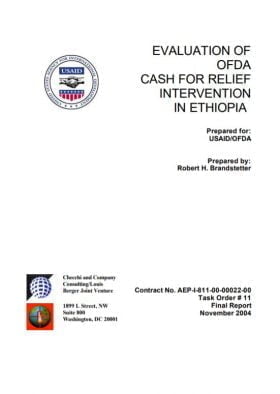Evaluation of OFDA Cash for Relief Intervention in Ethiopia: Final Report
As a result of insufficient rainfall in 2002 and 2003, the Ethiopian Disaster Prevention and Preparedness Commission (DPPC) issued an international appeal for food assistance in December 2003. Some 7.2 million people were estimated to be at risk in 2004. An OFDA/DART’s response to this crisis resulted in more than $31.9 million in support of humanitarian assistance in FY 2003 and a commitment of $17.4 million in FY 2004. These funds helped meet Ethiopia’s priority relief needs, which included assistance with: health and nutrition, agriculture, water and sanitation, local NGO capacity building and strengthening livelihoods. Part of the livelihoods intervention was the new and innovative Cash for Relief (CfR) program. This program was designed to provide small cash grants over a three to six month period directly to the most vulnerable households (HH). The objective of these grants was to assist beneficiaries to rebuild HH assets lost as a result of the drought and to help improve their livelihoods. Four NGOs with long experience in Ethiopia were selected to implement pilot CfR projects.
The purpose of the evaluation was to determine the effectiveness and overall impact of the CfR activities, and compare implementation approaches. After a rapid review of documents in Washington, the evaluator carried out fieldwork in Ethiopia from August 13 to September 10, 2004. The methodology employed standard rapid assessment procedures, and included document review, interviews and focus groups. Site visits were made to completed CfR programs in the SNNP, Oromiya and Amhara regions. Samples in each region of all primary participants and stakeholders were interviewed.
The CfR intervention is one of the most powerful and elegant relief techniques available. Used in coordination with food relief and under the right conditions which include: (a) local availability of food, (b) proximity to markets, and (c) adequate transport infrastructure, the intervention has a strong multiplier effect. It saves lives, it gives people dignity, it empowers women and it maintains and helps rebuild HHs. The cash grant reduces dependency on food aid and stimulates local markets, and the distribution of cash is 40% more cost-efficient for donors and NGOs than the traditional distribution of imported grain. The use of government mandated Employment Generation Schemes (EGS) as part of the CfR projects has the potential of creating long term, sustainable environmental and public works improvements. One anomaly in the intervention was the use of beneficiary allotments to pay government land taxes. The evaluation found no substantive problems with any of the implementation programs.



